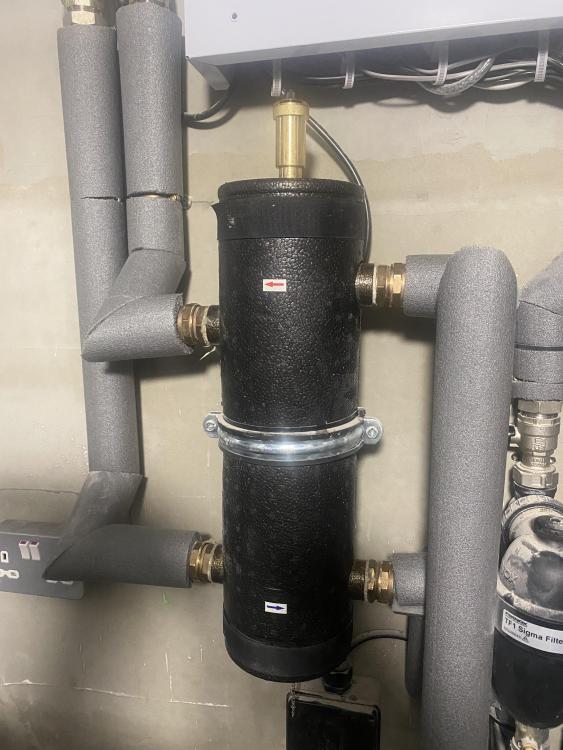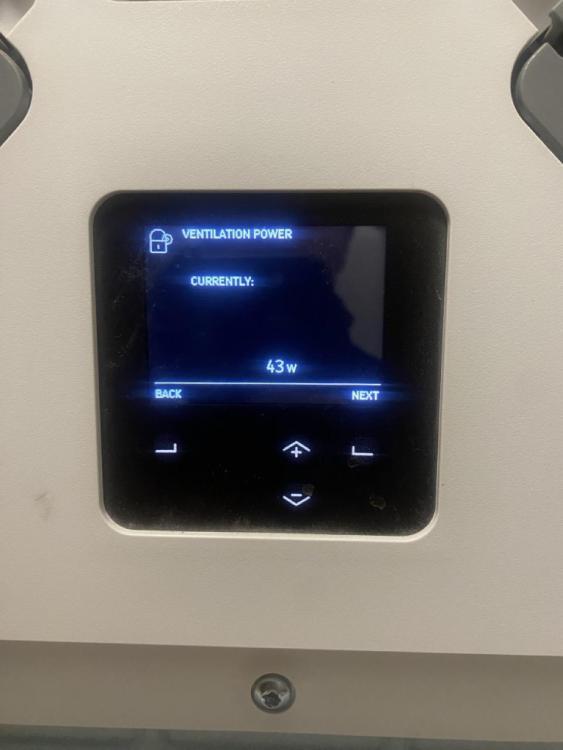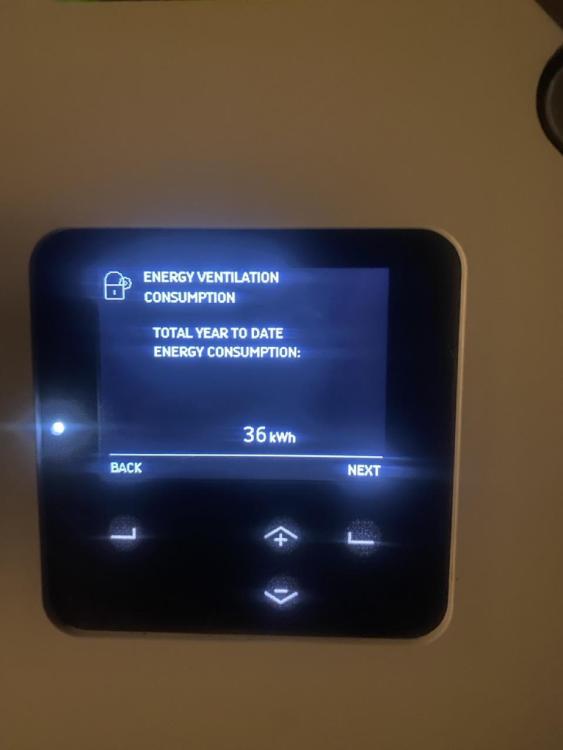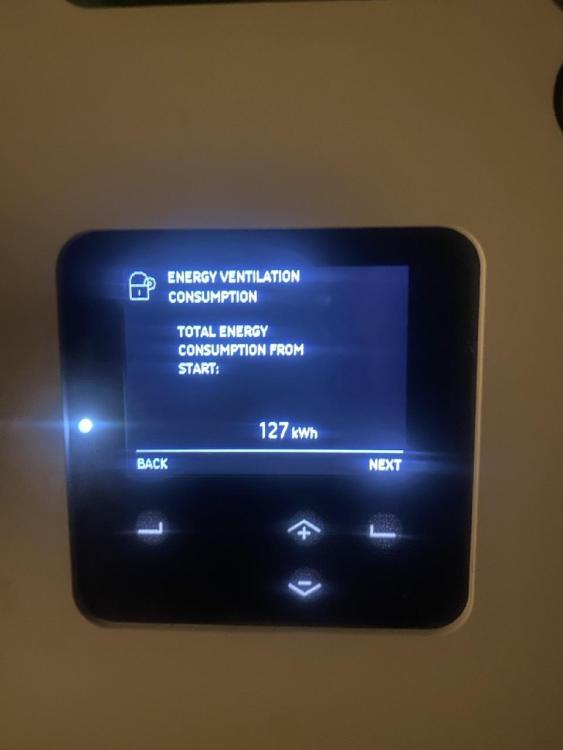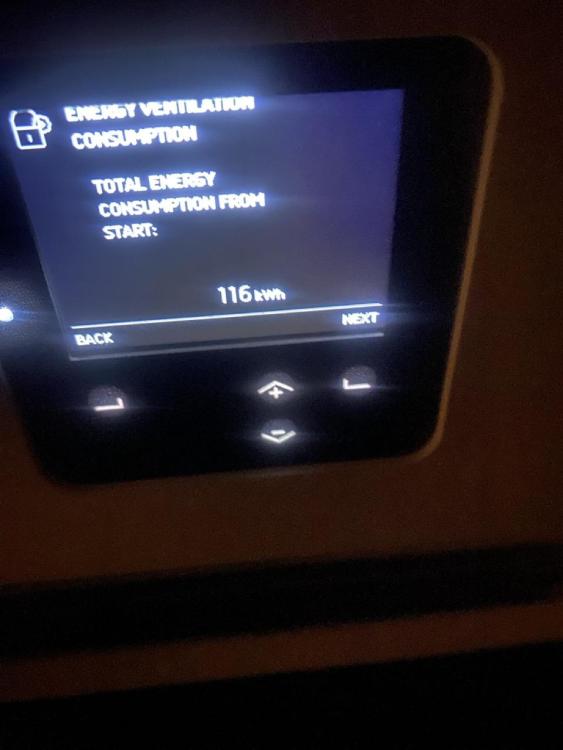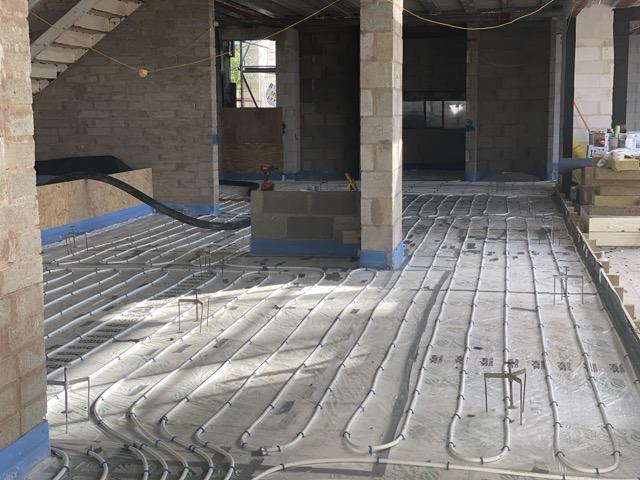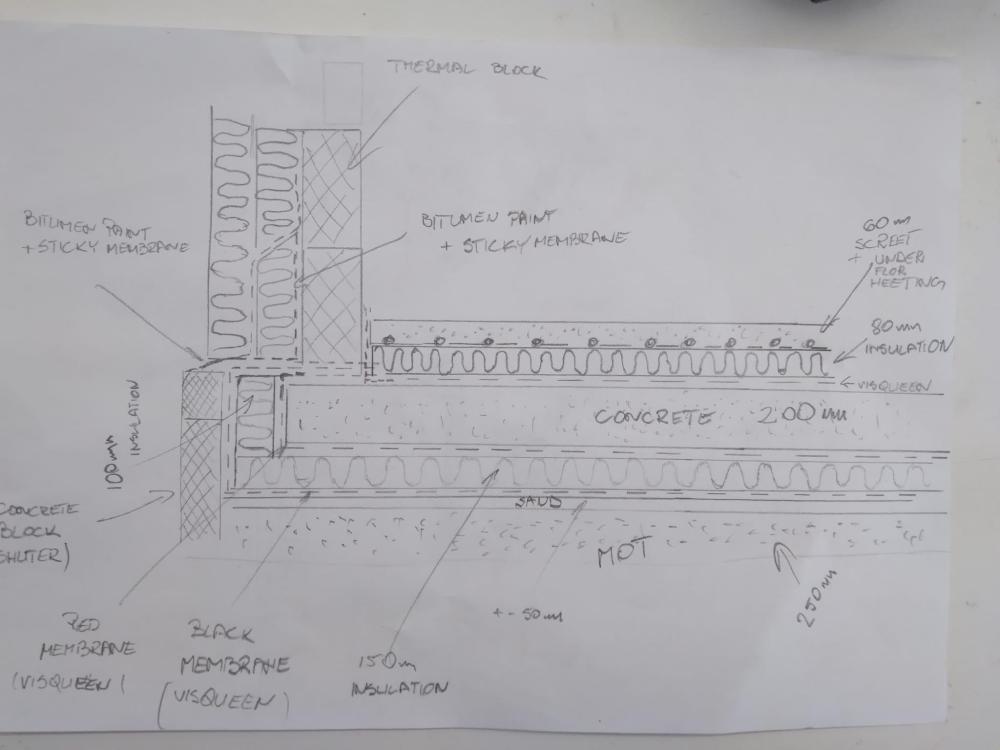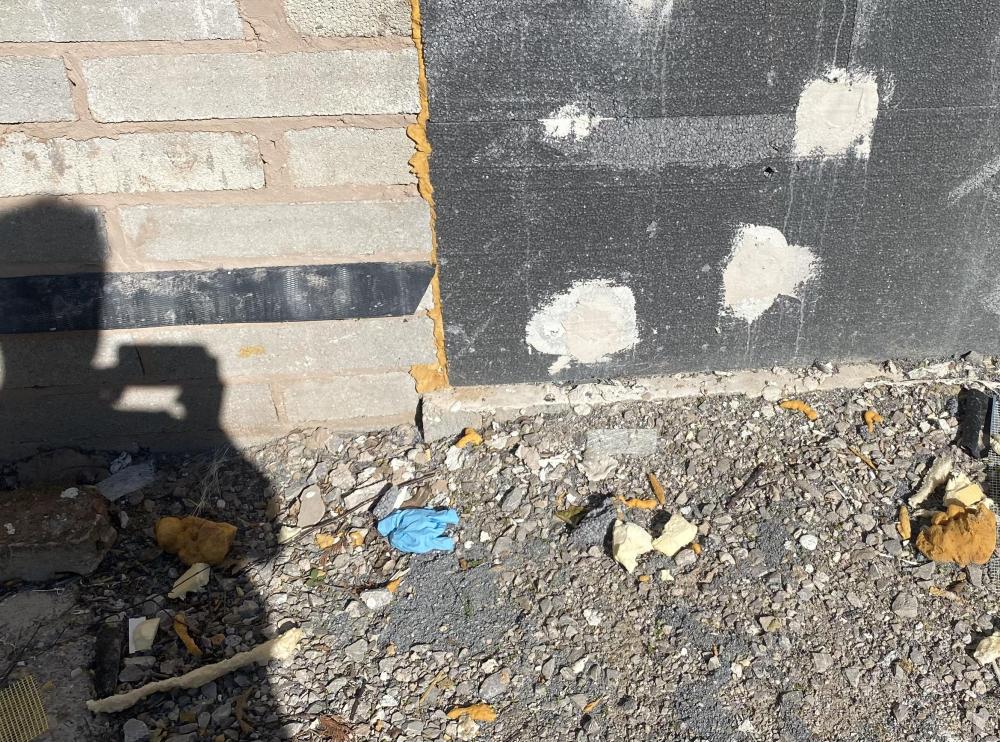
Carpe Diem
Members-
Posts
28 -
Joined
-
Last visited
Everything posted by Carpe Diem
-
Hi, I have an ongoing issue with the ASHP on a property I've built. In summary, we have a passivhaus c.450sqm with an 8kw ASHP, underfloor heating throughout. The ASHP was installed by Magna Renewables, and it's now got to the point that NICEIC have had to step in, and I'd like some independent advice as the installer hasn't resolved. We have 3 main problems. 1.Soon after install the energy usage was really high. Much higher than estimated. He is blaming Loxone because we have thermostats in each room and his view is that if it is calling when a single room cools, it is short cycling. Fair enough, but his solution is to remove loxone and have a single thermostats for the entire ground floor and one for the first floor. This doesn't work for me as a solution as we want individual control. There is no buffer tank. There is a low loss header. My (uneducated) view is that buffer may help resolve the issue as it would stop a small top up demand causing the ASHP to run. We have a 300l tank for hot water. Any thoughts? 2. Since the engineer last visit, we have to keep tipping by up the tank as the pressure drops. Takes about a week to go from 1.7bar to 0bar. He is saying he will put leak stop in the system as we can't see any sign of leaks. This is after I turned off the valves to the UFH and hot water return, which he was saying is where the leak most likely was. I turned them off because I was panicking we had a big leak in the UFH so I figured if I turned them off, and the pressure stopped dropping then this was the cause. But it carried on, so he has now accepted it is in their install (somebody else did the UFH and hot water in the house). Will leak stop work? Where is the leak if we can't see it? Is leak stop a bodge? all pipes are in ceiling and its been ongoing for over 6 months and no wet marks. 3. Every so often we have no hot water. When I check, the immersion heater is running like it is doing a legionella cycle but that's been turned off. The immersion says it is in but the tank keeps cooling. My suggestion is the element isn't working but he says he has checked power and it's fine. Note "power"..... he hasn't checked the element is working. anybody else seen this? Thanks all!
-
Passivhaus Under Floor Heating & Water Supply
Carpe Diem replied to Carpe Diem's topic in Underfloor Heating
But that then means that if, for example, one room is calling for a tiny amount of heat (2% valve open) that the heat pump runs. What I am seeing from the Loxone app is that the heat is called for frequently in small amounts to maintain the temperature of the slab, which I presume helps with efficiency. But, is this not bad when it keeps calling the heat and short cycling it? -
Passivhaus Under Floor Heating & Water Supply
Carpe Diem replied to Carpe Diem's topic in Underfloor Heating
Yes, TLA's are the devils work. I have attached a pic of the black unit. Not good that it adds inefficient. Any suggestion on how to change this or how they could/should have done? He definitely said that it does not take the heated water from the HW cylinder so it must have an emersion heater in it. They are going to look at introducing a small cylinder just for the UFH but he said to wait and give it a few weeks or months first and see how we get on. By which point... winter will be over of course so no heating likely. Ref the CoP and curve; he said to start it off as recommended and if the house is warm..... reduce the curve every few days. Generally, I tend to find the house is too warm in the bedrooms in the bedrooms of an evening. -
Passivhaus Under Floor Heating & Water Supply
Carpe Diem replied to Carpe Diem's topic in Underfloor Heating
Ok, so the company that installed have visited today and found several things out and also made some changes. He wasnt sure what UVC or OP stood for???? The UFH does not pull hot water from the HW tank. There is a separate vessel next to it, small black unit about the the size of 8/10 litres, that circulates and heats the water for the UFH. He found that the top up valve had been left open, so the tank was getting topped up with cold water.... wasting the hot water. The pressure was at 2.4bar, which he said is high, but must be the pressure at which the water into the property is at, otherwise it would continue to increase. Seems low pressure to me, but that is what he reckons it is correct. He adjusted the compensation curve and set the tank temp to 50c, whilst changing the control unit so it now shows energy consumption. At -3c external temp the curve is set at 40c. At 10c it is set at 32c. He reckons to try the HW running on a schedule of a few hours in the morning and a few in the evening, to see if that is enough for the usage. Outside of those hours it will use the tank hot water, which will obviously cool throughout the day. Any thoughts? -
Passivhaus Under Floor Heating & Water Supply
Carpe Diem replied to Carpe Diem's topic in Underfloor Heating
Not sure how we could retro fit that, but it would be good to have a motion sensor at floor level that brings on the night light on the switch. -
Passivhaus Under Floor Heating & Water Supply
Carpe Diem replied to Carpe Diem's topic in Underfloor Heating
We have Loxone control the blinds, MVHR etc. Its fully automated throughout, so I was hoping the issue with the heating cost was largely due to ASHP not being configured correctly. However, I now think that it may be a fundamental issue with the system specified. When the UFH is called even a tiny amount it seems the ASHP kicks in 100% so its costing £100s of elect on ASHP to heat £1s of space. I could change Loxone so that the heat isnt called until the temp is called in (for example) 2 rooms, or % open is 50%, but that could be false economy if it then takes x10 longer to heat the space. Any suggestions? How can I check if I have a UVC v OP (no idea what that actually means btw)??? Ref Loxone and confusing guests....Triple tap we have for night move, but its not common to tell someone to do this. When its night and the switches arent illuminated (we dont have the glow light on next to the beds) it can be confusing for a guest to press the switch and one of the corners and bring the radio on or open the blinds. Its not the end of the world, but in IMHO... it looses some of the premium feel when people are confused. Everything else is on motion sensors, which people like. Still prefer to an overly confusing C4 interface... but thats just my experience. -
Hi, We have recently completed a project that is Loxone and Delta Light throughout. Most of the circuits are Dali. We have an issue where some lamps have a residual glow, which I understand is common and easy to resolve.... except we dont seem to be able to resolve it. We have 2 main areas where this is an issue and one is really strange. 2 Issues: 1. We have 12 lights in a double height hall way, all wired the same with one driver between 2 lamps. 6 glow and 6 dont, yet they are all the same lamp, same driver, same settings. Any ideas? 2. We have 3 lamps on a single driver. With one lamp it is fine, we put 3 lamps on and it glows. These are easy to access as they are in the ground, so we put a tester on it and there is still 1.5v through the driver even when turned 0% on. Delta Light has said to include a 27k restistor. We did that and no difference. We even put 3 in series and no dimming at all. Is this an issue with the Dali module from Loxone, the driver or the lamps both from Delta Light, or something else?
-
- loxone
- delta light
-
(and 1 more)
Tagged with:
-
Passivhaus Under Floor Heating & Water Supply
Carpe Diem replied to Carpe Diem's topic in Underfloor Heating
Loxone is pretty good for the lighting and heating from my short experience. The media side of things I have not been impressed with, but my biggest mistake is the HDAnywhere setup, just seems pointless and cheaper to buy Apple TV's in everyroom. The main challenge we have is getting others used to Loxone, e.g. when guest stay over. Talking about night mode and tripple tapping, compared to say a C4/Lutron with a nice labels switch on the wall...... its confusing. -
Passivhaus Under Floor Heating & Water Supply
Carpe Diem replied to Carpe Diem's topic in Underfloor Heating
I have tweaked it down a bit, and what we can do is write a command so that if it is only one room at 5% it doesnt call. We could delay it so that it has to be 2 or 3 rooms calling, or a greater difference. -
Passivhaus Under Floor Heating & Water Supply
Carpe Diem replied to Carpe Diem's topic in Underfloor Heating
I have 2 x Q350's. Currently, they both have 43w being used. Year to date 36kWh. The usage is pretty low compared to what the ASHP is using. -
Passivhaus Under Floor Heating & Water Supply
Carpe Diem replied to Carpe Diem's topic in Underfloor Heating
Pros and cons though.... we dont have to worry about the temperature in any rooms and have no hot or cold spots. In another house we have it setup with one zone and its not great if doors are closed etc as we basically have to set the thermostat to 23C in the hall, and know that then means the bedrooms off it are near 21c. When its a sunny day, the room at the back that gets all the sun over heats, because the hall is in the shade so it is not externally heated. At least with sensor in each room, we have all the rooms perfectly balanced to the same temp. -
Passivhaus Under Floor Heating & Water Supply
Carpe Diem replied to Carpe Diem's topic in Underfloor Heating
Pros and cons though.... we dont have to worry about the temperature in any rooms and have no hot or cold spots. In another house we have it setup with one zone and its not great if doors are closed etc as we basically have to set the thermostat to 23C in the hall, and know that then means the bedrooms off it are near 21c. When its a sunny day, the room at the back that gets all the sun over heats, because the hall is in the shade so it is not externally heated. At least with sensor in each room, we have all the rooms perfectly balanced to the same temp. -
Passivhaus Under Floor Heating & Water Supply
Carpe Diem replied to Carpe Diem's topic in Underfloor Heating
It looks like the comp curve is set + or - X degrees based on the temp from outside. I dont really want to be messing/adjusting the temp frequently, id rather have it automatic.... which I am guessing that based on the outside temp reading it is automatic, if the curve is set correctly. However, I am not sure what the curve +- is of..... is the room temp? When you say, shouldnt be bounding off the thermostat, do you mean the rooms should not hit the max temp? If so, then in theory they wont (give or take the +-0.5c variance. Or, I can change it back to flow temp? and if so, what temp would you recommend. It just seems wrong that if there is a tiny demand in one room, that the ASHP is running as though it is heating the whole house, when it should just be a small amount. -
Passivhaus Under Floor Heating & Water Supply
Carpe Diem replied to Carpe Diem's topic in Underfloor Heating
@JohnMo I did originally have the controller set on flow temp, but the installing company then change it to compensation curve. I am not sure what the best setting is to have - flow, or curve. The Tank temp is set at 50c, and currently shows the tank being at 44.5c. When it was set to Flow temp, it was set at 38c. -
Passivhaus Under Floor Heating & Water Supply
Carpe Diem replied to Carpe Diem's topic in Underfloor Heating
The spec supplied said 200mm centres, but I thought the installer had said that the spec from pipe supplier wasnt based on a passivhaus house, with the slab insulation we had so he advised on making it wider. The span in the pic is 3m wide and I think 24 loops. -
Passivhaus Under Floor Heating & Water Supply
Carpe Diem replied to Carpe Diem's topic in Underfloor Heating
@MPH243 Is that via the Lan C module? It would seem that without the Lan C module installed, you get nothing out of the system other than going to the interface and looking at all the settings. TBH, I have been disappointed that this isn't standard, or wasn't specified when commissioning. My system does not have that. Zehnder have said to install the Option Box which seem to allow control but no output. @IanR Thanks for the reply.... good to see another Loxone user. What information do you get from your heating into Loxone? Yes, the kwh is average from 11th Nov to 5th Feb. I will ask the question, as I am not sure about the internal resistance heating. Maybe the video helps? -
Passivhaus Under Floor Heating & Water Supply
Carpe Diem replied to Carpe Diem's topic in Underfloor Heating
Hopefully, this is all relevant. I have uploaded a video of the setup I have here.... https://youtu.be/UFWexaN-h6o (it will be available from 12:00 today, still uploading whilst writing) And a video of the Loxone interface here..... https://youtube.com/shorts/4K4lUXrkWxI I have also attached some images for reference. In the video, you can see the heat pump is running for UFH. This is because the Master Ensuite has a call for heat, minimal as the valve is 5% open as can be seen in the other video. The valve is open because the temp 21.7c in the room, and it should be 21.5c. There is a variance of .5c, so in this instance it is calling for heat upto 22c then would stop. Every other room is fine. I have adjusted the temp control from 21.5c to 21c in the image IMG_5342.png, which automatically falls outside of the .5c variance and the valve automatically went to 0% open and the UFH call was stopped. Just thought that would explain the system and how it works. I have also attached images from the Mitsubishi Ecodan MEL Cloud software for past 24 hours. This shows the hourly temperate both internally, and externally (which I presume it gets from the ASHP unit itself). You can see that yesterday, 67.9% of the the time it was calling for heat..... which seems crazy. It wasnt that cold, but a tiny 5% open on a single valve seems to make the heat pump kick in full power and run continuously rather than just taking some hot water from the tank. Does this help? -
Passivhaus Under Floor Heating & Water Supply
Carpe Diem replied to Carpe Diem's topic in Underfloor Heating
Sure, I will get some more specific details of the install and setup. The construciton is a thermo block and external insulation. The slab has been down near 18 months and roof has been on for c.12 months - so relatively dry. I figure its more a case of too much water around the system and not enough power so its over working and emptying itself and its stuck in a cycle of the constant demand.... just a hunch. The Q350 I found two sites, one saying max consumption 131 and another 175W, but I guess that is on boost - which ours never is. The automation is more for lighting control, security etc - the heating part of it should just be in the background. The sensors are more for humity checking to boost MVHR (not configured yet) -
Passivhaus Under Floor Heating & Water Supply
Carpe Diem replied to Carpe Diem's topic in Underfloor Heating
Im in Cheshire, UK. The house is really well insulated too. 200mm of EPS insulation on all the walls and c.300mm to 500mm of insulation on the flat roof. I thought 40kWH per day was high considering that is not any of the lighting or plug circuit, its literally just the ASHP and MVHR units. We are a little warmer, c.21C average throughout. We have two Zehnder Q350s running that say Consumption is 131w to 175W, so 350W max total. So .35kWH x 24 = 8.4kWh. So c.32kWh being used by the ASHP. That also exclude anything I generate from the PV panels on the roof - granted int he winter it is low, but I figure it balances out some of the MVH. How can I go about demonstrating this to the installing and progressing it so that they address it? Technically, I am unsure of what to say... because they have been pretty despondent. -
Passivhaus Under Floor Heating & Water Supply
Carpe Diem replied to Carpe Diem's topic in Underfloor Heating
Firstly, thanks for the replies.... answering them one after another... The floor sits on a raft... minimum 100mm MOT, them 100mm of XPS Ratherm Insulation, then 175mm concrete, then another 100mm insulation and the final c.70mm of screed with the pipes at 250mm centres in most places. Yes, it was a new build, first heating period. There is only one tank, the 300L DHW cyclinder. There is a splitter valve that comes out of the cyclinder and diverts the water to the UFH circuit, or the hot water circuit. My understanding was that the underfloor draws the water from the tank, which then makes the tank cold as cold water from the UFH circuit mixes which then makes the tank cold, so when that drops below a temperature, it turns off the UFH, fills the tank and repeats. Is that wrong? The house is fully automated via Loxone. We have switches/sensor in every room that act as the thermostats, humidity sensors etc. They tell the pumps when to come on and which valves to open. We have 4 manifolds -> left and right of the house on each floor. I have attached the airtightness test result. 0.59. There is 3 people usually in the house, no excessive use, couple of showers etc. The heating kicks in every time it drops below the room temp, which varies from 19.5C in some rooms to 21.5C in others. That is set from 7 till 10:30, 7 days a week, then it drops to Eco mode -2.5C below the comfort settings. Hot water I think is just permanent to keep the tank at the set temp. I was involved in the plumbing to the extent I know how it is done. We use Multipipe 16mm pipe to each room that runs of a central return flow system that is on 32mm pipe. Boiler is at one end of the house, so to the longest point it will be c.25m both ways, 50m in total that will run through the 32mm pipe, and then be called off to the 16mm when the tap/shower is open. @Conor - How did you work this out? "However, I do think the heatpump is undersized. We're 315m², same assumed heat load of 15W/m², and have a 9kW heatpump. We used 20kWh on the worst winter days, including working from home, washing machine etc etc. The pump they've installed will mean it needs to be on 24x7 in the coldest weather and not much room left for hot water." I feared it was too small and not able to handle the load. Thanks Bill Airtightness Test 24.07.2023_Redacted.pdf -
Hi, Wondering if I can gain some insights from the community on my setup.... I have attached the proposal the company I used supplied for installing the UFH and Hot Water system in my house. We have been in since November and found that we are using c.40kWh per day on electricity from the grid. We only have electricity. I have a few concerns..... The company were great when they were doing the install, but afterwards I have not been impressed with the service. They came back and reinstalled all the PV units (not the panels) because they said they were installed wrong. This was after they signed it off. I was told I would get a new sign off, but this has not happened and I have chased. I have a couple of minor leaks on the system and it didnt seem to be setup correctly as they did not do a formal handover. They have come out (not addressed the leaks as yet) or done the handover, but they did change it so that the unit is set on Curve with a tank temperature of 50c. It took a week to heat the house up. When I felt the hot water return pipe from on the boiler it was always luke warm. Hot water also seems to take around 2 to 3 minutes to arrive when the tap is turned on. The house is c.450sqm. My concerns are: 1. Have they under specified the heating supply / tank? Its only a 300L system and we have a lot of underfloor heating to fill.... is it simply too small. The home automation company think that for a property of this size, they would normally have 2 tanks - one just for UFH and one for hot water. 2. We can only have hot water or UFH. So if the tank is being heated by a shower, the UFH demand exists from the home automation system, but the valve does not switch to prioritise the UFH. This in itself is dine, as we would expect the shower (for example) to get the hot water and the UFH to wait. But the home automation system does not know this (its Loxone) so it think it takes longer than it actually to heat up, which messes with its brain... which makes it think it make take 3 hours to heat a room instead of 2.5hrs, but somebody was showering for 30mins. Not a major issue, but do you just live with this? 3. Is the 40kWh excessive? That is literally just the energy for the Heat Pump and MVHR units. Thanks in advance! Bill Report_Redacted.pdf
-
Yes, I meant it will be indoors. thanks for the links
-
Hi, I am building a property and there has been a change to the design which means that a foul water access point that has already been installed is not going to be internal in the property - its a link between the garage and utility which is now to be enclosed. Is this allowable? Its obviously not ideal, but the alternative is a huge amount of work and potentially not even possible.
-
Eps insulation used over xps at ground floor level
Carpe Diem replied to Carpe Diem's topic in Brick & Block
Thanks Simon. Do you know of anything I can refer to documentation wise? -
We are just about to start thin coat rendering and I have noticed that in some areas he has used a combination of xps and eps insulation. In most places it is 200mm of xps but in a couple of areas, he has used 100mm of xps against the wall and then 100mm of eps on the face side. insualtion on the external. He reckons it will be fine but I am concerned that the eps insulation below ground will cause an issue. It will be against gravel. the wall with no insulation is a garden wall the property joins but you can see the dpc level here. Any comments?

